


This key is the famous "mouse" key of World War II, one of the workhorse keys used by the German military. This particular key is dated 1941. Like most mouse keys, it has a flip up cover. It is a small key, only three inches by one and a half inches. It is mounted on a flat piece of sturdy metal like many other German keys from WWII. The knob is slightly concave which is also typical of German keys in general. The plastic parts are a marbled brown color, like what radio collectors call a "Catalin."

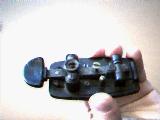
This is also a German mouse key, though it is missing both the flip up cover as well as the metal base. The date on this key is 1943. Mouse keys were manufactured between 1940 and 1944. The knob on this one however is only semicircular. Compare it to the mouse key above. The keys with the full round knob were training keys, and the ones with the half-round knob were the operator's keys (info from Rolf, DK1ZH). The bottom of this key has "TKP" stamped into it from the time of manufacture. Does anyone have any info on what this could have stood for?

This key is labeled "Baumuster: T1." It is commonly known as the German T1. It is also referred to as a "Siemens Key" (see MM46, pg 44). The T1 was the subject of a QST article in January 1944. It seems one was picked up in Italy by W9UIN, captured from the German forces there. The article contains a picture of the key and describes the plastic dust cover and the rubber bottom with large "pimples" on it to keep it from slipping on any surface. The lettering on the top cover reads "Pull plug before opening!" The last paragraph of the article reads:
"All in all, a nice job. But we want to know where the Jerries got that rubber!"
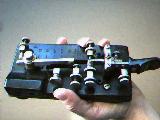
The Novoplex was produced for hams. It bears the symbol of the pre-war German organization radio club DASD = Deutscher Sende- und EmpfangsDienst. The Novoplex was built by the Charlottenburger Motoren und Geraetebau, the Charlottenburg Motor and Tool Works. Charlottenburg is a suburb of Berlin, in an area that until recently was West Berlin. The base of the bug is plastic and it has large rubber suction cup type feet. All electrical connecting strips are enclosed within the base. I am looking for more info on dating the Novoplex.
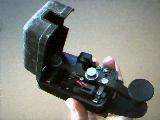
This key is the "Lorenz key," or German T2. It can be seen in Morsum Magnificat Number 46, page 44, on the very left. It is shown with the Siemens key, and I believe it likely that it was a contemporary. It also sports a flip top, but has a metal apron which comes out under the knob instead of the metal base extending out as a rectangle. Like the Siemens key, it has a nonslip rubber pad on the bottom, but with a crosshatch pattern. The plastic block on the left with the red "lightning" arrow on it appears to be a door interlock switch, to prevent the key from functioning unless the cover is engaged down. If anyone has further info on when the Lorenz keys were produced, please let me know.
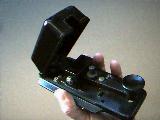 This is a key for which I have very little information. It appears to be of similar design to
the other German keys of this era, but may have been made a little later. It was made by Widmaier,
in Munich. It is heavy plastic and has a fliptop. It is more blocky and less intricate than
the other keys of the same era. Info on this key would be appreciated.
This is a key for which I have very little information. It appears to be of similar design to
the other German keys of this era, but may have been made a little later. It was made by Widmaier,
in Munich. It is heavy plastic and has a fliptop. It is more blocky and less intricate than
the other keys of the same era. Info on this key would be appreciated.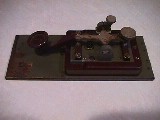
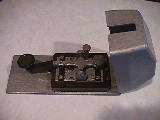
In 1926 engineer and marine captain Joseph Junker founded a factory in Berlin in which he made radio equipment as well as equipment for submarines. One of his earliest products was the Junker telegraph key. Apparently, Junker also made a bug that looks very similar to the Vibroplex Lightning Bug. At the end of World War II, Junker moved the factory to Bad Honnef. Joseph Junker died in 1946. The company bearing his name, however, still produces fine morse keys to the present time. An earlier Junker key, missing the fliptop, is seen on the left. The later model on the right says "Bad Honnef/Rh" on the base and is called the "M.T." There have not been many changes between the two.
These are probably Italian collapsible miniature keys, made to be mounted in or on the side of a transmitter, possibly a field or clandestine one. They flip open and closed with the flick of a finger. They are about 2.5 inches long in greatest dimension. You can see that they are of similar construction. The metal plate hides a coil spring that aids in the closure of the device. They are probably Post-War items.

| Select a Resistance and Voltage then *Click* the Switch! |

 Back to the Index
Back to the Index